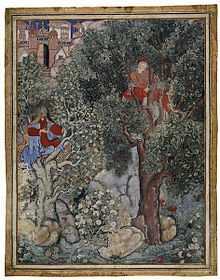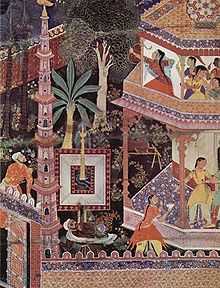Hamzanama





The Hamzanama (Persian/Urdu: حمزه نامه, Epic of Hamza) or Dastan-e-Amir Hamza (Persian/Urdu: داستان امیر حمزه, Adventures of Amir Hamza) narrates the legendary exploits of Hamza bin Azrak, a brave man who lived in the Banu abbas reign, though most of the story is extremely fanciful, "a continuous series of romantic interludes, threatening events, narrow escapes, and violent acts".[1] In the West the work is best known for the enormous illustrated manuscript commissioned by the Mughal Emperor Akbar in about 1562.
The text augmented the story, as traditionally told in dastan performances. This romance originated more than 1,000 years ago, probably in Persia, and subsequently spread throughout the Islamic world in oral and written forms. The Dastan (story telling tradition) about Amir Hamza persists far and wide up to Bengal and Arakan (Burma) due to Hamza's wide travelling in Persia, Central Asia, India, Himalayan region, Burma and probably in Malaysia in his youth[2]
Akbar's manuscript
Though the first Mughal Emperor, Babur, described the Hamzanama as "one long far-fetched lie; opposed to sense and nature",[3] his grandson Akbar, who came to throne at the age of fourteen, greatly enjoyed it. He commissioned his court workshop to create an illustrated manuscript of the Hamzanama early in his reign (he was by then about twenty), which was conceived on such an unusually large scale that it took fourteen years, from about 1562 to 1577, to complete. Apart from the text, it included 1400 full page Mughal miniatures of an unusually large size, nearly all painted on paper, which were then glued to a cloth backing. The work was bound in 14 volumes. After the early pages, where various layouts were experimented with, one side of most folios has a painting, about 69 cm x 54 cm (approx. 27 x 20 inches) in size, done in a fusion of Persian and Mughal styles. On the other side is the text in Persian in Nasta'liq script, arranged so that the text is opposite the matching picture in most openings of the book.[4]
The size of the commission was completely unprecedented, and stretched even the huge imperial workshop. According to contemporary accounts, about thirty main artists were used, and over a hundred men worked on the various aspects of the book in all. According to Badauni and Shahnawaz Khan the work of preparing the illustrations was supervised initially by Mir Sayyid Ali and subsequently by Abdus Samad, the former possibly being replaced as head of the workshop because the pace of production was too slow. After seven years only four volumes were completed, but the new head was able to galvanize production and complete the ten volumes in another seven years, without any loss of quality. Indeed, "the later pages are the most exciting and innovative in the work".[5]
The colophon of this manuscript is still missing. None of the folios of this manuscript so far found is signed, though many have been attributed to different artists. Compared to Akbar's Tutinama, a smaller commission begun and completed while the Hamzanama commission was in progress, the manuscript shows a much greater fusion of the styles of Indian and Persian miniatures. Though the elegance and finish may seem closer to Persian works, the compositional style and narrative drama owe more to Indian tradition. Between them, these two manuscripts are the key works in the formation of the Mughal miniature style.[6]
Only a little over a hundred of the paintings survive. The largest group is 61 in the Austrian Museum of Applied Art (MAK) in Vienna, with the rest spread over many collections, including the Victoria and Albert Museum, with 27 (bought in Kashmir), and the British Museum in London.[7] The MAK organized in 2009 the exhibition GLOBAL:LAB, Art as a Message. Asia and Europe 1500-1700, which showed its whole holding of the Hamzanama.[8] Other recent exhibitions dedicated to the manuscript have been at the Victoria and Albert Museum in 2003 and in 2002/2003 at the Smithsonian in Washington D.C. which transferred to the Brooklyn Museum in New York.[9]
Other versions
The Dastan-e-Amir Hamza existed in several other illustrated manuscript versions. One version by Navab Mirza Aman Ali Khan Ghalib Lakhnavi was printed in 1855 and published by the Hakim Sahib Press, Calcutta, India. This version was later embellished by Abdullah Bilgrami and published from the Naval Kishore Press, Lucknow, in 1871. Two English language translations have been published. The first is available in an expanded version on the website of the translator Frances Pritchett, of Columbia University.[10] In 2007 Musharraf Ali Farooqui, a Pakistani-Canadian author, translated the Ghalib Lakhnavi/Abdulla Bilgriami version into English.
The story is also performed in Indonesian puppet theatre, where it is called Wayang Menak. Here, Hamzah is also known as Wong Agung Jayeng Rana or Amir Ambyah.
Notes
- ↑ Beach, 61
- ↑ see Asim Roy, 1983, The Islamic Syncretistic Tradition in Bengal, Sterling: New Delhi, pp. 104–5; The Bustan of Amir Hamzah (the Malay version of Dastan-e-Amir Hamza);Farooque Ahmed, The Sangai Express-Imphal, May 25, 2006 Amir Hamza-book review, muslimmedianetwork.com/mmn/%3Fp%3D1824
- ↑ Beach, 60
- ↑ Beach, 61
- ↑ Beach, 61
- ↑ Grove
- ↑ Titley, 189; V&A Museum. Titley says "Only just over one hundred of the paintings have survived", while the V&A says "About 140", but they are counting fragments.
- ↑ exhibition GLOBAL:LAB, 03.06.2009 - 27.09.2009 at the MAK Vienna
- ↑ V&A
- ↑ Pritchett, Frances. "The Romance Tradition in Urdu: The Adventures from Dastan-e Amir Hamza". Retrieved 11 August 2012.
References
- Beach, Milo Cleveland, Early Mughal painting, Harvard University Press, 1987, ISBN 0-674-22185-0, ISBN 978-0-674-22185-7
- "Grove", Oxford Art Online, "Indian sub., §VI, 4(i): Mughal ptg styles, 16th–19th centuries", restricted access.
- Titley, Norah M., Persian Miniature Painting, and its Influence on the Art of Turkey and India, 1983, University of Texas Press, 0292764847
- Farooqi, Musharraf Ali (2007), The Adventures of Amir Hamza (New York: Random House Modern Library).
- The Bustan of Amir Hamzah (the Malay version of the story).
- Musharraf Farooqi (2009), (transl.Tilism-e hoshruba, vol. 1 of Jah):Hoshruba, Book One: The Land and the Tilism, by Muhammad Husain Jah).
- Seyller, John (2002), The Adventures of Hamza, Painting and Storytelling in Mughal India, Freer Gallery of Art and Arthur M. Sackler Gallery, Smithsonian Institution, Washington, DC, in association with Azimuth Editions Limited, London, ISBN 1-898592-23-3 (Contains the most complete set of reproductions of Hamzanama paintings and text translations.)
Further Reading
- Kossak , Steven (1997). Indian court painting, 16th-19th century.. New York: The Metropolitan Museum of Art. ISBN 0870997831. (see index: p. 148-152; plate 7-8)
External links
| Wikimedia Commons has media related to Hamzanama. |
- The Adventures of Amir Hamza - the first complete and unabridged translation of the Dastan-e Amir Hamza
- Online exhibit of The Adventures of Hamza at the Smithsonian Institution
- A Masterpiece of Sensuous Communication: The Hamzanama of Akbar (images in pdf file, Section II )
- Hamzanama at the Victoria & Albert Museum, London
- Frances Pritchett's website for 'The Romance Tradition in Urdu: The Adventures from the Dastan-e Amir Hamza